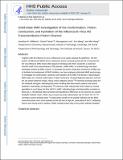Solid-State NMR Investigation of the Conformation, Proton Conduction, and Hydration of the Influenza B Virus M2 Transmembrane Proton Channel
Author(s)
Wang, Jun; Williams, Jonathan Kyle; Tietze, Daniel; Lee, Myungwoon; Hong, Mei
Downloadnihms842983.pdf (3.451Mb)
PUBLISHER_POLICY
Publisher Policy
Article is made available in accordance with the publisher's policy and may be subject to US copyright law. Please refer to the publisher's site for terms of use.
Terms of use
Metadata
Show full item recordAbstract
Together with the influenza A virus, influenza B virus causes seasonal flu epidemics. The M2 protein of influenza B (BM2) forms a tetrameric proton-conducting channel that is important for the virus lifecycle. BM2 shares little sequence homology with AM2, except for a conserved HxxxW motif in the transmembrane (TM) domain. Unlike AM2, no antiviral drugs have been developed to block the BM2 channel. To elucidate the proton-conduction mechanism of BM2 and to facilitate the development of BM2 inhibitors, we have employed solid-state NMR spectroscopy to investigate the conformation, dynamics, and hydration of the BM2 TM domain in lipid bilayers. BM2 adopts an α-helical conformation in lipid membranes. At physiological temperature and low pH, the proton-selective residue, His19, shows relatively narrow ¹⁵N chemical exchange peaks for the imidazole nitrogens, indicating fast proton shuttling that interconverts cationic and neutral histidines. Importantly, pH-dependent ¹⁵N chemical shifts indicate that His19 retains the neutral population to much lower pH than His37 in AM2, indicating larger acid-dissociation constants or lower pK[subscript a] 's. We attribute these dynamical and equilibrium differences to the presence of a second titratable histidine, His27, which may increase the proton-dissociation rate of His19. Two-dimensional ¹H-¹³C correlation spectra probing water ¹H polarization transfer to the peptide indicates that the BM2 channel becomes much more hydrated at low pH than at high pH, particularly at Ser12, indicating that the pore-facing serine residues in BM2 mediate proton relay to the proton-selective histidine.
Date issued
2016-07Department
Massachusetts Institute of Technology. Department of ChemistryJournal
Journal of the American Chemical Society
Publisher
American Chemical Society (ACS)
Citation
Williams, Jonathan K. et al. “Solid-State NMR Investigation of the Conformation, Proton Conduction, and Hydration of the Influenza B Virus M2 Transmembrane Proton Channel.” Journal of the American Chemical Society 138, 26 (June 2016): 8143–8155 © 2016 American Chemical Society
Version: Author's final manuscript
ISSN
0002-7863
1520-5126